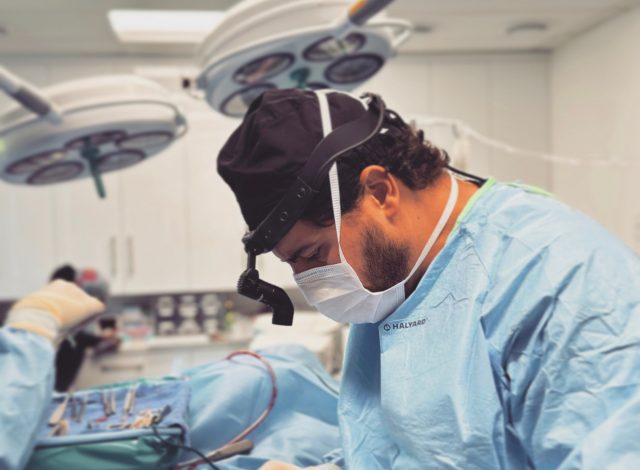Dr. Abou Chacra, who is the Medical Director of Clinique 7, in Montreal, Canada, has performed countless Rhinoplasty procedures. Rhinoplasty, popularly known as a nose job, is often perceived primarily as a cosmetic surgery aimed at enhancing facial aesthetics. However, this procedure goes beyond just altering the nose’s appearance. It plays a crucial role in improving nasal function and breathing. This aspect of rhinoplasty, sometimes overshadowed by its cosmetic counterpart, is vital for individuals struggling with breathing difficulties due to the structure of their noses. Today, Dr. Abou Chacra hopes to inform those who suffer from sleep apnea and other breathing-related issues.
Dr. Abou Chacra on Understanding the Functional Benefits of Rhinoplasty
Correcting Structural Irregularities
The primary functional benefit of rhinoplasty is correcting structural irregularities in the nose that can impede normal breathing. These irregularities include:
Functional rhinoplasty is a surgical procedure that aims to address various nasal issues that can impact breathing function. One of the most common issues that functional rhinoplasty can address is a deviated septum. A deviated septum occurs when the thin wall between the nasal passages is displaced to one side, causing obstruction and difficulty in breathing. This can lead to symptoms such as snoring, congestion, and sleep apnea.
Another issue that functional rhinoplasty can address is enlarged turbinates. Turbinates are structures inside the nose that help to cleanse and humidify the air as it passes through. However, when they become enlarged, they can block airflow and cause breathing difficulties. This can be due to various reasons, such as allergies, infections, or structural abnormalities.
Additionally, nasal valve collapse is another issue that functional rhinoplasty can address. This condition occurs when the nasal valves, which are located in the narrowest part of the nasal airways, weaken and collapse during inhalation, restricting airflow. This can result in symptoms such as shortness of breath, fatigue, and difficulty exercising.
Overall, functional rhinoplasty can be an effective solution for individuals who struggle with breathing difficulties due to nasal issues such as a deviated septum, enlarged turbinates, or nasal valve collapse.
Zahi Abou Chacra on Relief from Chronic Conditions
Functional rhinoplasty can also provide relief from chronic conditions such as:
Rhinoplasty, also known as nose surgery, is a surgical procedure that can improve the airflow in the nasal passages. This improvement in airflow can alleviate certain types of sleep apnea, a sleep disorder characterized by pauses in breathing during sleep. By correcting structural issues in the nose, rhinoplasty can help in resolving recurring sinus infections or sinusitis. Sinusitis is a condition that causes inflammation of the sinus lining, leading to congestion, pain, and difficulty breathing through the nose. In many cases, obstructed nasal passages can be a contributing factor to sinusitis. By fixing these issues, rhinoplasty can help provide relief and improve overall quality of life.
Dr. Chacra on The Procedure: What to Expect
Consultation and Evaluation
A thorough consultation with a qualified surgeon is the first step. Here, medical history, nasal functionality, and aesthetic goals are discussed. The surgeon will examine the internal and external structure of the nose to identify the specific issues affecting breathing.
Dr. Chacra on Surgical Techniques
The actual surgery may involve:
Septoplasty is a surgical procedure that is performed to straighten a deviated or crooked septum, which is the wall of cartilage and bone that separates your two nostrils. This surgery aims to improve breathing by clearing the nasal passages and enhancing airflow.
Turbinate reduction is another surgical procedure that aims to increase airflow by decreasing the size of the turbinates, which are small structures inside the nose that help warm and moisturize the air we breathe. This procedure is usually performed alongside septoplasty.
Nasal valve repair is a surgical technique that involves reinforcing or widening the nasal valves to prevent their collapse. The nasal valves are narrow areas in the nasal passages where the airway is most constricted, leading to breathing difficulties. This procedure can be performed in conjunction with septoplasty and turbinate reduction to achieve the best possible results.
Zahi Abou Chacra on Recovery and Outcomes
Post-surgery, patients typically experience swelling and some discomfort, but these subside within a few weeks. Breathing improvements can be noticed almost immediately, though full benefits are realized once the healing is complete.
Dr. Chacra on The Cosmetic Aspect: A Secondary Benefit
While the primary focus is on improving nasal function, rhinoplasty can also bring cosmetic changes. Many patients appreciate the dual benefits — enhanced breathing and a more balanced nasal appearance. Surgeons often work with patients to address both functional and aesthetic goals.
Zahi Abou Chacra on Choosing the Right Surgeon
Selecting a surgeon experienced in both the cosmetic and functional aspects of rhinoplasty is crucial. A skilled surgeon ensures not only an aesthetically pleasing outcome but also a structurally sound and functionally improved nose.
Rhinoplasty is more than a cosmetic procedure; it’s a life-changing surgery for many who struggle with breathing issues. By addressing structural problems, it can significantly improve the quality of life, demonstrating that its value extends well beyond aesthetic enhancement. For those considering rhinoplasty, understanding its functional benefits is key to making an informed decision about this transformative procedure.








